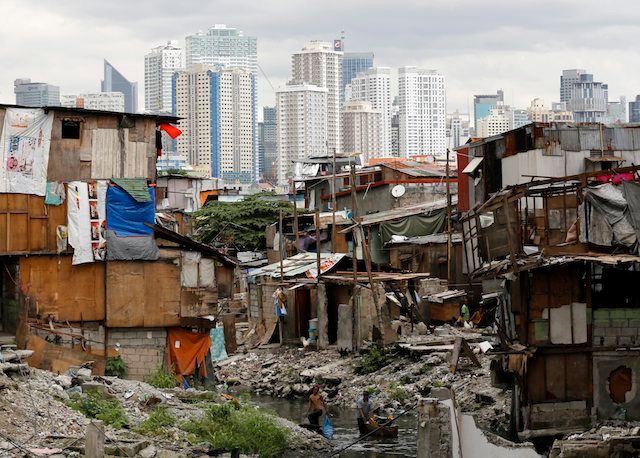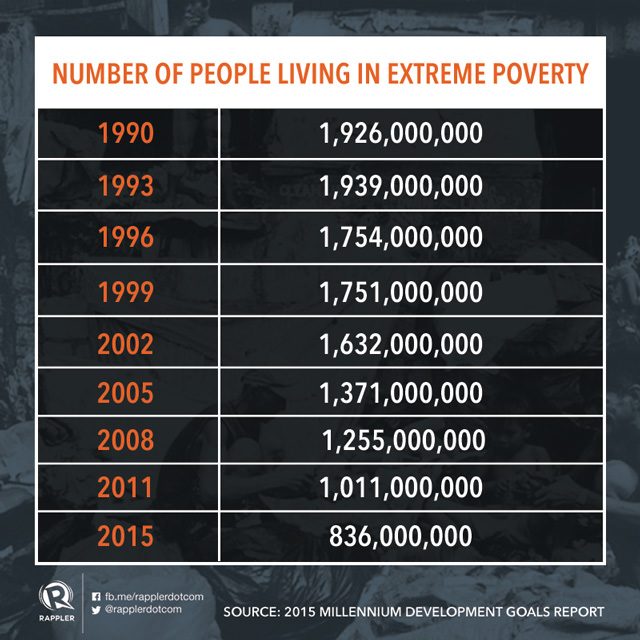SUMMARY
This is AI generated summarization, which may have errors. For context, always refer to the full article.

MANILA, Philippines – The Millennium Development Goals (MDG) deadline has passed, and what now?
According to the final MDG report launched by the United Nations (UN) on Tuesday, July 7, the “success” in meeting set goals will pave the way for the new sustainable development agenda being adopted in 2015.
The annual assessment of global and regional progress found that the 15-year effort to achieve the goals set during the Millennium Declaration in 2000 was “largely successful” globally.
Goal-setting, the UN report confirms, can relieve the world of its problems such as poverty, hunger, and social inequality, among others. Targeted interventions, strategies, adequate resources, and firm political will are important in attaining progress, even in the poorest sector.
“The MDGs have greatly contributed to this progress and have taught us how governments, business and civil society can work together to achieve transformational breakthroughs,” UN Secretary-General Ban Ki-moon said in a statement.
Decreased poverty, hunger
The goals set produced the “most successful anti-poverty movement in history,” the report said, and it will now serve as a “springboard” to realize the post-2015 agenda.
The population living in extreme poverty has been halved. From 1990’s 1.9 billion, there are now 836 million people surviving with only $1.25 (P56.39)* a day, with progress recorded mostly since 2000.
In 2015 alone, it is estimated that 175 million are going to be lifted out of poverty.

Meanwhile, the number of people suffering from hunger and undernourishment has decreased throughout the 15 years.
The prevalence of undernourishment among children under 5 years old has been halved from 1990’s 31% to 2015’s 16%. This pulls down underweight children from one in 5 to only one in 7 children.
The decline, according to the report, is continuous but “not fast enough” and will need more push in the years to come.
Inequality among countries and social classes however remain constant. This leaves significant gaps that may hinder developing countries from attaining progress and eventual eradication of hunger and poverty. (READ: ADB: Specter of inequality to haunt strong PH economy)
The world’s poorest are distributed “very unevenly” across regions and countries. An overwhelming majority of people who try to survive under the poverty line – 80 % of the global total of extremely poor people – can be found in two regions: Southern Asia and Sub-Saharan Africa.
Meanwhile, 490 million people or two-thirds of the global population of people suffering from hunger reside in Asia Pacific despite successfully achieving the target. (READ: Asia Pacific still home to most of world’s undernourished – report)
Far from over
It cannot be denied, however, that extreme poverty still exists despite the “enormous” progress achieved. Almost 800 million people are still burdened by hunger and poverty, limiting their potential.
These people are more likely to still suffer from risks due to health disadvantages, child and maternal mortality, elevated school dropout rates, and inadequate sanitation. In fact, the report added that about 16,000 children die each day before they reach their 5th birthday due to these factors.
The target of halving the population might have been met but the UN admits the world is far from eradicating poverty and hunger – at least a generation more.
“Following profound and consistent gains, we now know that extreme poverty can be eradicated within one more generation,” Ban Ki-moon said.
In addition, those who have successfully managed to be pulled out of the poverty and hunger trap are still very vulnerable and their relief are deemed temporary. They can be pushed back again due to looming factors such as economic shocks, food insecurity, and climate change.
To address this, leaders around the world have called for an “ambitious” long-term sustainable agenda post-MDG that would build on its success.
“The emerging post-2015 development agenda, including the set of Sustainable Development Goals, strives to build on our successes and put all countries, together, firmly on track towards a more prosperous, sustainable and equitable world,” Ban Ki-moon explained. – Rappler.com
Add a comment
How does this make you feel?





There are no comments yet. Add your comment to start the conversation.